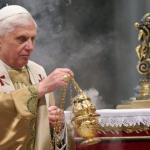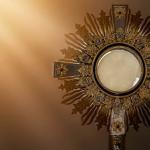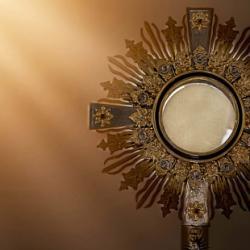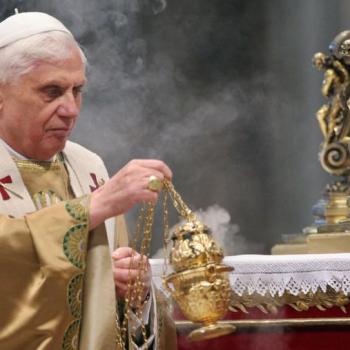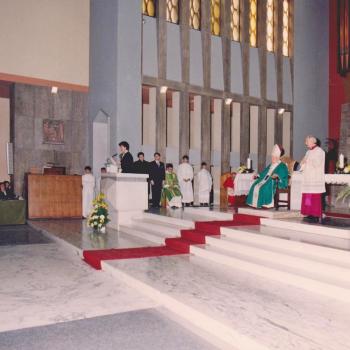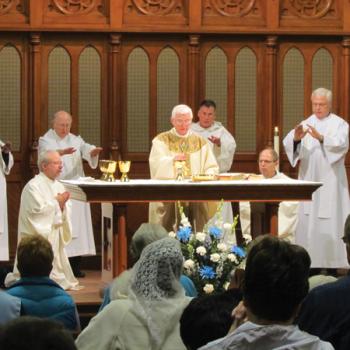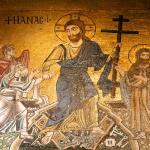Part V: Pope Francis’s Liturgical Vision – Embracing Unity and Fostering Formation
Editor’s note: This is the fifth and final article in a series by Andrew Likoudis entitled “The Liturgical Reform – Council, Consilium, and Papacy.” Click here for Part 1: “The liturgical path of the Church after Vatican II.” Click here for Part 2: “The Post-Conciliar Era: The Church and the rise of traditionalism.” Click here for Part 3: “John Paul II and the Liturgical Reforms.” Click here for Part 4: “Benedict XVI’s Liturgical Vision: Summorum Pontificum and Beyond.”
In July of 2021, Pope Francis issued Traditionis Custodes, a motu proprio that significantly restricts the 1962 Roman Missal, and seeks to gather together the faithful of the Latin Church around a singular form of the Roman Rite.
He prefaces his reasons for this decision by briefly outlining the recent history of the expanded use of the 1962 Missal under Pope Benedict XVI:
It comforted Benedict XVI in his discernment that many desired “to find the form of the sacred Liturgy dear to them,” “clearly accepted the binding character of Vatican Council II and were faithful to the Pope and to the Bishops.” What is more, he declared to be unfounded the fear of division in parish communities, because “the two forms of the use of the Roman Rite would enrich one another”. Thus, he invited the Bishops to set aside their doubts and fears, and to welcome the norms, “attentive that everything would proceed in peace and serenity,” with the promise that “it would be possible to find resolutions” in the event that “serious difficulties came to light” in the implementation of the norms “once the Motu proprio came into effect.”
Pope Francis then delineates his role in the assessment of the situation, during his own pontificate,
With the passage of thirteen years, I instructed the Congregation for the Doctrine of the Faith to circulate a questionnaire to the Bishops regarding the implementation of the Motu Proprio Summorum Pontificum. The responses reveal a situation that preoccupies and saddens me, and persuades me of the need to intervene.[1]
Thus, he concluded that there could no longer be an ordinary and an extraordinary form, due to the weaponization of a form of the liturgy of the Church against the Church’s Magisterium and juridical authority. The issuance of Traditionis Custodes therefore abrogated the prescriptions of Pope Benedict XVI and establish the reformed Missal — also known as the Mass of Paul VI — “as the unique expression of the lex orandi of the Roman Rite.”[2] Pope Francis further justified his decision, writing,
Regrettably, the pastoral objective of my Predecessors, who had intended ‘to do everything possible to ensure that all those who truly possessed the desire for unity would find it possible to remain in this unity or to rediscover it anew,’[3] has often been seriously disregarded. An opportunity offered by St. John Paul II and, with even greater magnanimity, by Benedict XVI, intended to recover the unity of an ecclesial body with diverse liturgical sensibilities, was exploited to widen the gaps, reinforce the divergences, and encourage disagreements that injure the Church, block her path, and expose her to the peril of division.[4]
Within this act of new legislation, Pope Francis lamented the need to restrict a prominent feature of the Church’s living patrimony, in large part due to rejection of the teachings of the Second Vatican Council and the popes that followed. In explaining his decision, he identified the pre-conciliar form of the liturgy as an unfortunate rallying point for dissension and the growth of ideological factions that display tendencies of undermining the Magisterium (teaching authority) of the Church.
Pope Francis’s decision to issue Traditionis Custodes was primarily rooted in a desire to uphold the unity of the Church and to ensure that the reforms of Vatican II were being faithfully implemented,[5] and that the Office of Peter — the visible center of unity of the Church — was being given due respect and deference.
He wrote in the letter accompany this legislation:
I am … saddened that the instrumental use of Missale Romanum of 1962 is often characterized by a rejection not only of the liturgical reform, but of the Vatican Council II itself, claiming, with unfounded and unsustainable assertions, that it betrayed the Tradition and the “true Church.”
… One is dealing here with comportment that contradicts communion and nurtures the divisive tendency—“I belong to Paul; I belong instead to Apollo; I belong to Cephas; I belong to Christ”—against which the Apostle Paul so vigorously reacted. In defense of the unity of the Body of Christ, I am constrained to revoke the faculty granted by my Predecessors. The distorted use that has been made of this faculty is contrary to the intentions that led to granting the freedom to celebrate the Mass with the Missale Romanum of 1962. Because “liturgical celebrations are not private actions, but celebrations of the Church, which is the sacrament of unity”, they must be carried out in communion with the Church.
… Sacrosanctum Concilium explained that the Church, the “sacrament of unity,” is such because it is “the holy People gathered and governed under the authority of the Bishops.”
… St. Paul VI, recalling that the work of adaptation of the Roman Missal had already been initiated by Pius XII, declared that the revision of the Roman Missal, carried out in the light of ancient liturgical sources, had the goal of permitting the Church to raise up, in the variety of languages, “a single and identical prayer,” that expressed her unity. This unity I intend to re-establish throughout the Church of the Roman Rite.[6]
Thus, the new Motu Proprio removed the decision-making power over the use of the 1962 Roman Missal from individual priests and groups of the faithful, placing it back into the hands of local bishops, under the direction of the Dicastery for Divine Worship.[7]
Clarifications and Guidance: Responsa ad Dubia and Rescriptum ex Audientia
The Vatican released both a Responsa ad Dubia[8] (issued December, 2021) and a Rescriptum ex Audientia[9] (February, 2023) to provide further clarifications on Traditionis Custodes. These documents emphasize the bishop’s central role in overseeing the use of the Tridentine Mass within their dioceses, underlining the importance of unity and adherence to the Council’s reforms, and answering questions about some of the restrictions found in Traditionis Custodes.
The Congregation for Divine Worship confidently stated that:
The text of the Motu Proprio (Traditionis Custodes) and the accompanying Letter to the Bishops of the whole world clearly express the reasons for the decisions taken by Pope Francis. The first aim is to continue “in the constant search for ecclesial communion”[10] which is expressed by recognizing in the liturgical books promulgated by the Popes Saint Paul VI and Saint John Paul II, in conformity with the decrees of the Second Vatican Council, the unique expression of the lex orandi of the Roman Rite.[11] This is the direction in which we wish to move, and this is the meaning of the responses we publish here. Every prescribed norm has always the sole purpose of preserving the gift of ecclesial communion by walking together, with conviction of mind and heart, in the direction indicated by the Holy Father. … When Pope Francis reminds us that ‘after this magisterium, after this long journey,[12] We can affirm with certainty and with magisterial authority that the liturgical reform is irreversible’ he wants to point us to the only direction in which we are joyfully called to turn our commitment as pastors.
The Responsa further reiterated the view of St. John Paul II as seen in Vicesimus Quintus Annus,[13] the opinion of Pope Benedict,[14] and the position of Pope Francis when it formally expresses the position of the Church hierarchy, stating unequivocally in response to a dubium about Article 4 of Traditionis Custodes:
This reform has enhanced every element of the Roman Rite and has fostered—as hoped for by the Council Fathers—the full, conscious and active participation of the entire People of God in the liturgy,[15] the primary source of authentic Christian spirituality.[16]
The question of the place of the pre-conciliar Missal in the future life of the Church remains. It has not been abrogated. Its current restrictions are significant; however, the Holy Father’s purpose has not been to stamp out the pre-conciliar form, a form that he supported during his time as Archbishop of Buenos Aires, establishing a fixed place for its weekly celebration only two days after the issuance of Summorum Pontificum.[17] He also stated that the restrictions of Traditionis Custodes did not apply to the Priestly Fraternity of St. Peter which has the celebration of the Mass with the preconciliar Missal written into its constitution. Rather his goal, in issuing these new regulations, seems to be to seek the reestablishment of substantial unity of the faithful under the Mass of Pope St. Paul VI.
This does not necessarily mean that there will be no place for celebration with the pre-conciliar Missal in years to come, but this might also depend directly on how well unity is reestablished, and whether polemics and infighting cease.
Desiderio Desideravi: A Vision for the Future
Pope Francis’s approach to liturgy, as reflected in his decisions and writings, is quite forward-looking. He stresses the importance of moving beyond rigid and ideological adherence to past forms (while also recognizing the value that our patrimony holds and can teach us[18]) and instead focusing on how liturgical practices can serve the Church’s mission today. He writes,
For this reason we cannot go back to that ritual form which the Council fathers, cum Petro et sub Petro, felt the need to reform, approving, under the guidance of the Holy Spirit and following their conscience as pastors, the principles from which was born the reform. The holy pontiffs St. Paul VI and St. John Paul II, approving the reformed liturgical books ex decreto Sacrosancti Œcumenici Concilii Vaticani II, have guaranteed the fidelity of the reform of the Council. For this reason I wrote Traditionis custodes, so that the Church may lift up, in the variety of so many languages, one and the same prayer capable of expressing her unity.[19]
His vision thus encompasses an acknowledgement of the role tradition plays, and how it can guide us, as a recognition of the need for liturgical formation and renewal in our context today, as well as an application of the Church’s doctrines and praxis that adequately responds to contemporary challenges.
The Faithful’s Role: Docility and Reverence
Pope Francis, today, calls on the faithful to receive the Church’s teachings and decisions with reverent submission and to carry them out even despite the sacrifice they entail, for the good of the whole Church, its mission, and thus also, for the whole common good, and the good of all souls. This obligation is grounded in a sober understanding of the Liturgy’s centrality in the life of the Christian (really at the center of the order of creation). It also requires us to reflect deeply on the Pope’s role as the Vicar of Christ, who exercises the authority of Christ over the whole Church, so that the Church can act as one Body of Christ, and thus also as one Sacrament of Salvation for the world.
The Holy Father has stressed the need for unity and obedience, within the ecclesiological understanding of authority solidified at Vatican I and further developed and outlined in Lumen Gentium,[20] Dei Verbum,[21] [22] and The Catechism of the Catholic Church.[23]
He enumerated this explicitly in Desiderio Desideravi, writing,
It would be trivial to read the tensions, unfortunately present around the celebration, as a simple divergence between different tastes concerning a particular ritual form. The problematic is primarily ecclesiological.[24]
Conclusion
In conclusion, Pope Francis’s liturgical directives, encapsulated in Traditionis Custodes, the accompanying Responsa ad Dubia and Rescriptum ex Audientia, and his Apostolic Letter, Desiderio Desideravi highlight his commitment to the principles of the Second Vatican Council as well as moving beyond it, in seeking out new ways to engage modern man, through the authority vested in him to guide the Church in the Third Millennium.
He seeks to lead the Church towards a deeper understanding and more authentic expression of its liturgical life rooted in the realization that the liturgy is first about “[God’s] infinite desire to re-establish that communion with us that was and remains his original design, [which] will not be satisfied until every man and woman, from every tribe, tongue, people and nation,[25] shall have eaten his Body and drunk his Blood.”[26] Thus, the task we are called to by the Pope is in a rediscovery of the liturgy’s Christocentric and Marian dimensions—both through offering and receiving the Paschal Victim, and through a renewed reflection on the reason for our adoration, praise, and thanksgiving, as central features of the “wellspring of worship.”[27]
He also calls the faithful to a proper formation, making the distinction between a formation for proper celebration of the liturgy, and a formation by and through the liturgy.[28] He acknowledges the difficulties produced by the “liturgy wars,” recognizing that ideological imbalance and polemics have replaced proper formation. Thus, he stresses, that while rejecting certain excessive creativity and resulting abuses in the liturgy and recognizing the due respect owed the Church’s liturgical patrimony, there is also a need for contemporary people to rediscover the liturgy first and foremost as God’s meeting place with humanity, as a gift, and as an expression of God’s desire to “break bread” with us today.
As Dr. Timothy O’Malley, Academic Director of the Notre Dame Center for Liturgy has explained,
Pope Francis notes that even careful attention to the rubrics and the celebration of a beautiful liturgy does not lead to active or full participation. … Rather, liturgical renewal depends on amazement at the Paschal Mystery of Jesus Christ.[29]
Pope Francis writes in Desiderio Desideravi:
The astonishment or wonder of which I speak is not some sort of being overcome in the face of an obscure reality or mysterious rite. It is, on the contrary, marveling at the fact that the salvific plan of God has been revealed in the paschal deed of Jesus (cf. Eph 1:3-14), and the power of his paschal deed continues to reach us in the celebration of the ‘mysteries,’ of the sacraments.[30]
The Pope sees that for this formation in holy amazement to take place, the liturgy wars must cease, and the faithful must rediscover the unity of the Church, found in the Successor of Peter, and ultimately, in Christ. This may mean putting aside one’s preferences, and firstly “uniting oneself in mind and heart with the Roman Pontiff,”[31] receiving his teaching with docility, and accompanying him on the Barque of Peter in the direction indicated for the Church, especially as it has just crossed the threshold of the new millennium.[32] This is our God-given responsibility as the faithful of Christ’s one, holy, catholic, and apostolic Church.
Then may we see, the fruit of the reform in full bloom, as,
A foretaste of that heavenly liturgy which is celebrated in the holy city of Jerusalem toward which we journey as pilgrims, where Christ is sitting at the right hand of God, a minister of the holies and of the true tabernacle.[33] [34]
Notes:
[1] Pope Francis, Letter accompanying the Motu Proprio Traditionis Custodes; https://www.vatican.va/content/francesco/en/letters/2021/documents/20210716-lettera-vescovi-liturgia.html
[2] Pope Francis, Traditionis Custodes, §1.
[3] Benedict XVI, Letter Con Grande Fiducia accompanying Summorum Pontificum; AAS 99 (2007) 797-798.
[4] Pope Francis, Letter accompanying the Motu Proprio Traditionis Custodes; emphasis mine.
[5] See for another helpful analysis on this point: Sean Blanchard, PhD, “Traditionis Custodes Was Never Merely About the Liturgy” Church Life Journal, August 02, 2021; https://churchlifejournal.nd.edu/articles/traditionis-custodes-was-never-merely-about-the-liturgy/
[6] Pope Francis, Letter accompanying the Motu Proprio Traditionis Custodes; emphasis mine.
[7] This latter subsidiary relationship was later to be further delineated in a Rescriptum ex Audientia.
[8] Congregation for Divine Worship and the Discipline of the Sacraments, Responsa ad Dubia on certain provisions of the Apostolic Letter Traditionis Custodes can be found here: https://www.vatican.va/roman_curia/congregations/ccdds/documents/rc_con_ccdds_doc_20211204_responsa-ad-dubia-tradizionis-custodes_en.html
[9] The Rescriptum ex Audientia can be found here: https://press.vatican.va/content/salastampa/en/bollettino/pubblico/2023/02/21/230221a.html
[10] Pope Francis, Traditionis custodes, Preamble.
[11] Cf. Pope Francis, Traditionis custodes, §1.
[12] Pope Francis, Address to the participants in the 68th National Liturgical Week, Rome, 24 August 2017.
[13] Pope St. John Paul II, Vicesimus Quintus Annus: On the 25th Anniversary of the Promulgation of the Conciliar Constitution Sacrosanctum Concilium on the Sacred Liturgy, §12.
[14] Cardinal Joseph Ratzinger, Feast of Faith: Approaches to a Theology of the Liturgy (San Francisco: Ignatius Press, 1986), 87.
[15] Cf. Vatican II, Sacrosanctum Concilium, §14.
[16] Cf. Congregation for Divine Worship and the Discipline of the Sacraments, Responsa ad Dubia on certain provisions of the Apostolic Letter Traditionis Custodes; emphasis mine.
[17] This would seem to dispel any polemic that Pope Francis hates tradition, and what is erroneously called “The Mass of the Ages”; See, “Bergoglio presenta su renuncia como arzobispo de Buenos Aires, aunque seguirá en el cargo,” Terra Noticias. 15 December 2011; https://web.archive.org/web/20140701073209/http:/noticias.terra.com.ar/politica/bergoglio-presenta-su-renuncia-como-arzobispo-de-buenos-aires-aunque-seguira-en-el-cargo,148ef548c2444310VgnVCM20000099f154d0RCRD.html.
[18] See for an analogous example: https://www.vaticannews.va/en/pope/news/2023-06/pope-message-for-world-day-of-grandparents-and-elderly-2023.html.
[19] Pope Francis, Desiderio Desideravi, §61.
[20] See Lumen Gentium, §25: This religious submission of mind and will must be shown in a special way to the authentic magisterium of the Roman Pontiff, even when he is not speaking ex cathedra; that is, it must be shown in such a way that his supreme magisterium is acknowledged with reverence, the judgments made by him are sincerely adhered to, according to his manifest mind and will. His mind and will in the matter may be known either from the character of the documents, from his frequent repetition of the same doctrine, or from his manner of speaking.
[21] Dei Verbum, §8: This tradition which comes from the Apostles develop in the Church with the help of the Holy Spirit. (5) For there is a growth in the understanding of the realities and the words which have been handed down. This happens through the contemplation and study made by believers, who treasure these things in their hearts (see Luke, 2:19, 51) through a penetrating understanding of the spiritual realities which they experience, and through the preaching of those who have received through Episcopal succession the sure gift of truth.;
[22] Dei Verbum §10: the task of authentically interpreting the word of God, whether written or handed on, (8) has been entrusted exclusively to the living teaching office of the Church, (9) whose authority is exercised in the name of Jesus Christ. This teaching office is not above the word of God, but serves it, teaching only what has been handed on, listening to it devoutly, guarding it scrupulously and explaining it faithfully in accord with a divine commission and with the help of the Holy Spirit, it draws from this one deposit of faith everything which it presents for belief as divinely revealed. It is clear, therefore, that sacred tradition, Sacred Scripture and the teaching authority of the Church, in accord with God’s most wise design, are so linked and joined together that one cannot stand without the others, and that all together and each in its own way under the action of the one Holy Spirit contribute effectively to the salvation of souls.
[23] CCC 100: The task of interpreting the Word of God authentically has been entrusted solely to the Magisterium of the Church, that is, to the Pope and to the bishops in communion with him.
[24] Pope Francis, Desiderio Desideravi, §31.
[25] Rev. 5:9.
[26] Pope Francis, Desiderio Desideravi, §4.
[27] Cf. Jean Corbon, The Wellspring of Worship; The work of Jean Corbon, would seem to be one of Francis’s inspirations for Desiderio Desideravi, as noted by another prominent liturgist, (Cf. Rita Ferrone, “Earnest Desire”Commonweal Magazine, August 27, 2022; https://www.commonwealmagazine.org/earnest-desire); Jean Corbon was the author of CCC 2560 and 2561; CCC 2560 reads: “‘If you knew the gift of God!’ The wonder of prayer is revealed beside the well where we come seeking water: there, Christ comes to meet every human being. It is he who first seeks us and asks us for a drink. Jesus thirsts; his asking arises from the depths of God’s desire for us. Whether we realize it or not, prayer is the encounter of God’s thirst with ours. God thirsts that we may thirst for him.”; and CCC 2561 reads: “You would have asked him, and he would have given you living water.” Paradoxically our prayer of petition is a response to the plea of the living God: “They have forsaken me, the fountain of living waters, and hewn out cisterns for themselves, broken cisterns that can hold no water!” Prayer is the response of faith to the free promise of salvation and also a response of love to the thirst of the only Son of God.”
[28] Cf. Rita Ferrone, “Earnest Desire” Commonweal Magazine, August 27, 2022.
[29] Timothy P. O’Malley, PhD, “The only way forward in liturgical reform is to encounter the Lord” Our Sunday Visitor, August 29, 2022; This article is part 10 of a multi-part series exploring the gift and promise of Vatican II’s liturgical reforms.; cf. Pope Francis, Desiderio Desideravi, §23.
[30] Pope Francis, Desiderio Desideravi, §25.
[31] Pope Pius X, Major Catechism §204.
[32] See for further on this theme, Pope St. John Paul II, Tertio Millenio Adveniente: https://www.vatican.va/content/john-paul-ii/en/apost_letters/1994/documents/hf_jp-ii_apl_19941110_tertio-millennio-adveniente.html.
[33] Vatican II, Sacrosanctum Concilium, §8.
[34] I would be remiss if I ended this series without pointing the reader to the excellent and thorough multi-part series on the liturgical reform written by Drs. Mary Healy, John Cavadini, and Fr. Thomas Weinandy in ChurchLife Journal, collectively titled, “A Synoptic Look at the Failures and Successes of Post-Vatican II Liturgical Reforms”; https://churchlifejournal.nd.edu/articles/a-synoptic-look-at-the-failures-and-successes-of-post-vatican-ii-liturgical-reforms/.


